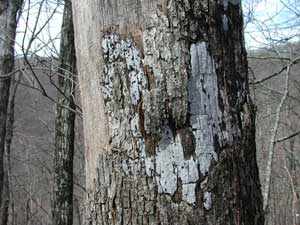Resource Library
Plant of the Week: Hypoxylon Canker
The University of Arkansas System Division of Agriculture does not promote, support or recommend plants featured in "Plant of the Week." Please consult your local Extension office for plants suitable for your region.
Plant of the Week
Hypoxylon Canker

Weather extremes happen, but 2011 has been one for the record books, especially in my part of northwest Arkansas. The year began with record cold and snowfall, followed by record-breaking rain and flooding, and finally ending up with record-breaking heat and drought. The heat and drought killed or is killing many plants, especially oaks, graveyard dead. The cause for the oak tree loss is a fungus disease called Hypoxylon canker.
Hypoxylon canker is a systemic fungus disease that invades oaks of both the white and red oak tribes. Attack by the fungus is usually fatal, with trees appearing to die suddenly, usually during the driest part of summer. Oftentimes it takes two years to kill a large oak, with the upper extremities of the tree turning yellow and dying the first year, followed by the death of the entire tree the second year. The symptoms of upper limb death are often missed, and frequently people cite that the tree just suddenly died.
The telltale sign of Hypoxylon canker is a pile of bark at the base of the trunk, or large pieces of bark popping off of large branches in the crown. These sheets of bark, often 6 to 18 inches long, are being pushed off by a hard, but fuzzy, brown fast-growing fungal mat that forms just beneath the bark. This stage of development represents the asexual stage (conidiospore) of disease spread, with the windborne spores produced en masse. In a few weeks, these fungal mats turn silvery and then black as the sexual stage of the disease develops. The larger sexual spores are produced inside the stroma and ooze to the surface of the mat, where they are carried by rainwater or insects to other trees.
The fungus spores are thought to invade branches and trunks through wounds. Following invasion, the fungus mycelium can grow as much as three feet in either direction along the stem during the first season. The optimal temperature for mycelium growth is 86 degrees.
The last widespread outbreak of this disease in Arkansas was in the early 1980s following that extreme drought year. Historical records indicate it was also present in the droughts of the mid-50s and probably 30s, but it wasn’t until the 1980 drought that it caught the attention of forest pathologists. The late U of A plant pathologist, Dr. Pat Finn, and his students demonstrated that most oak trees of all size classes in the Ozarks were systemically infected with the disease. But only during periods of extreme drought stress did the fungus become active and complete its mission and kill the tree. About 15 percent of the oaks in the Ozarks perished from the 1980 drought, but because many were small, the effect on the canopy seemed less.
The first Hypoxylon tree kills from the 2011 drought I observed were alongside the Fayetteville bike trail, which was finished during 2009. The oaks had a portion of their roots severed during trail construction and then were beset with a bad, but not extreme, drought in 2010. This summer the trees looked healthy until about August, when several large black oaks just suddenly died. As the trees were removed, the signs of Hypoxylon were apparent.
I speculate that the fungus mycelium is held in check by a healthy tree with normal levels of sap moisture in the trunk. But when drought strikes – either because the tree lost part of its root system or rainfall just didn’t come – the tree bole, or trunk, heats up and the fungus spreads rapidly. During the dust bowl drought of the 1930s, scientists took the temperature of tree trunks and found that drought-stressed trees ran consistently about 10 degrees hotter than non-drought stressed trees. From an ecological perspective, a fungal disease such as Hypoxylon would be a good thing because it indiscriminately thins the forest, reducing competition for the remaining trees. Of course, if your new home was built around that one special tree, then it is a bad thing indeed.
Unfortunately, there is no cure for this disease. The best advice we can give is to keep the trees healthy by watering before drought conditions become too extreme. Fertilization too is often recommended, but encouraging new growth during a drought period seems risky to me. Once symptoms develop, removing the tree and burning the wood will get rid of the fungal mats producing the spores. But even this recommendation is probably of little practical value, especially if it is true that most oaks are already systemically infected with the fungus.
I expect the first oaks afflicted with Hypoxylon canker brought on by the 2011 drought will begin dying during the fall of this year. In the 1980 drought, trees continued to die until the summer of 1983. It is likely to follow a similar course with this drought.
By: Gerald Klingaman, retired
Retired Extension Horticulturist - Ornamentals
Extension News - October 14, 2011
The University of Arkansas System Division of Agriculture does not maintain lists of retail outlets where these plants can be purchased. Please check your local nursery or other retail outlets to ask about the availability of these plants for your growing area.